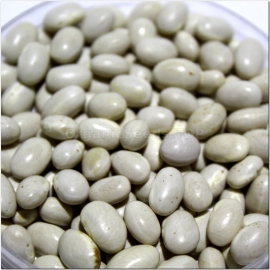


«Navy» - Organic Bean Seeds
1.14 €
Although now commonly referred to simply as 'Navy' beans, into the middle part of the twentieth century they were more commonly known as "Navy Peas." This name is in reference to it being a staple food stock for the American Navy in the early years.
-
Heirloom Bean «Navy»
Although now commonly referred to simply as 'Navy' beans, into the middle part of the twentieth century they were more commonly known as "Navy Peas." This name is in reference to it being a staple food stock for the American Navy in the early years.
Originally cultivated by the Native Americans in New York State, these small white beans remain one of the oldest varieties in cultivation. Also known as 'Boston Pea' or 'Navy Pea Bean'.
The bushy plants grow eighteen to twenty four inches tall and are very productive. The pods are about four inches long containing five to seven small, pure white seeds that are meaty and stay firm when cooked. They are an excellent choice for soups and baking. Stays firm even after reheating!
Like many families looking for ways to save money while still providing us healthy meals, my mother cooked a lot of 'Navy' beans, sometimes with a ham hock thrown in, while we were growing up. 'Navy' beans are also a great choice, and commonly used, for baked beans.
How to Plant
Amend the soil with compost before planting. Bush beans are grown differently than pole beans. Sow bush bean seeds 1 inch deep, spaced 2- to 3-inches apart in rows, 2 feet apart. Thin to 4- to 6-inches apart after the true leaves form. Pole beans are planted on 8-foot tall poles arranged in a row or a tepee. Plant 2 to 3 seeds spaced evenly around each pole. Pole beans naturally want to twine up the poles. You can also grow bush and pole varieties in containers in smaller spaces. Trellis pole beans with wire or twine hung from a porch ceiling or roof.
Fava beans are the exception in the bean family, but well adapted to our cool spring and fall growing conditions. Plant these as you would bush beans, but since the plants can grow 3- to 4-feet tall, trellis or stake the rows to keep the plants from flopping over.
If planting pole beans in the tepee shape, consider planting lettuce, or mesclun mix or radishes under the tepee. These quick maturing veggies will grow and mature before the pole beans grow up to shade them. It’s a great space saving tip in a small garden.
Consider planting successive crops of bush beans until early July spaced two weeks apart. This will insure a continuous harvest throughout the summer.
